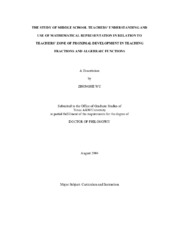| dc.contributor.advisor | Kulm, Gerald O. | |
| dc.creator | Wu, Zhonghe | |
| dc.date.accessioned | 2004-11-15T19:50:31Z | |
| dc.date.available | 2004-11-15T19:50:31Z | |
| dc.date.created | 2004-08 | |
| dc.date.issued | 2004-11-15 | |
| dc.identifier.uri | https://hdl.handle.net/1969.1/1218 | |
| dc.description.abstract | This study examined teachers' learning and understanding of mathematical representation through the Middle School Mathematics Project (MSMP) professional development, investigated teachers' use of mathematics representations in teaching fractions and algebraic functions, and addressed patterns of teachers' changes in learning and using representation corresponding to Teachers' Zone of Proximal Development (TZPD).
Using a qualitative research design, data were collected over a 2-year period, from eleven participating 6th and 7th grade mathematics teachers from four school districts in Texas in a research-designed professional development workshop that focused on helping teachers understand and use of mathematical representations. Teachers were given two questionnaires and had lessons videotaped before and after the workshop, a survey before the workshop, and learning and discussion videotapes during the workshop. In addition, ten teachers were interviewed to find out the patterns of their changes in learning and using mathematics representations.
The results show that all teachers have levels of TZPD which can move to a higher level with the help of capable others. Teachers' knowledge growth is measurable and follows a sequential order of TZPD. Teachers will make transitions once they grasp the specific content and strategies in mathematics representation. The patterns of teacher change depend on their learning and use of mathematics representations and their beliefs about them.
This study advocates teachers using mathematics representations as a tool in making connections between concrete and abstract understanding. Teachers should understand and be able to develop multiple representations to facilitate students' conceptual understanding without relying on any one particular representation. They must focus on the conceptual developmental transformation from one representation to another. They should also understand their students' appropriate development levels in mathematical representations.
The findings suggest that TZPD can be used as an approach in professional development to design programs for effecting teacher changes. Professional developers should provide teachers with opportunities to interact with peers and reflect on their teaching. More importantly, teachers' differences in beliefs and backgrounds must be considered when designing professional development. In addition, professional development should focus on roles and strategies of representations, with ongoing and sustained support for teachers as they integrate representation strategies into their daily teaching. | en |
| dc.format.extent | 612067 bytes | en |
| dc.format.extent | 297628 bytes | en |
| dc.format.medium | electronic | en |
| dc.format.mimetype | application/pdf | |
| dc.format.mimetype | text/plain | |
| dc.language.iso | en_US | |
| dc.publisher | Texas A&M University | |
| dc.subject | Middle school mathematics teachers' changes | en |
| dc.subject | teachers' zone of proximal development | en |
| dc.subject | mathematical representation | en |
| dc.subject | professional development | en |
| dc.subject | fractions and algebraic functions | en |
| dc.title | The study of middle school teachers' understanding and use of mathematical representation in relation to teachers' zone of proximal development in teaching fractions and algebraic functions | en |
| dc.type | Book | en |
| dc.type | Thesis | en |
| thesis.degree.department | Teaching Learning and Culture | en |
| thesis.degree.discipline | Curriculum and Instruction | en |
| thesis.degree.grantor | Texas A&M University | en |
| thesis.degree.name | Doctor of Philosophy | en |
| thesis.degree.level | Doctoral | en |
| dc.contributor.committeeMember | Loving, Cathleen C. | |
| dc.contributor.committeeMember | Capraro, Robert M. | |
| dc.contributor.committeeMember | Willson, Victor | |
| dc.type.genre | Electronic Dissertation | en |
| dc.type.material | text | en |
| dc.format.digitalOrigin | born digital | en |


